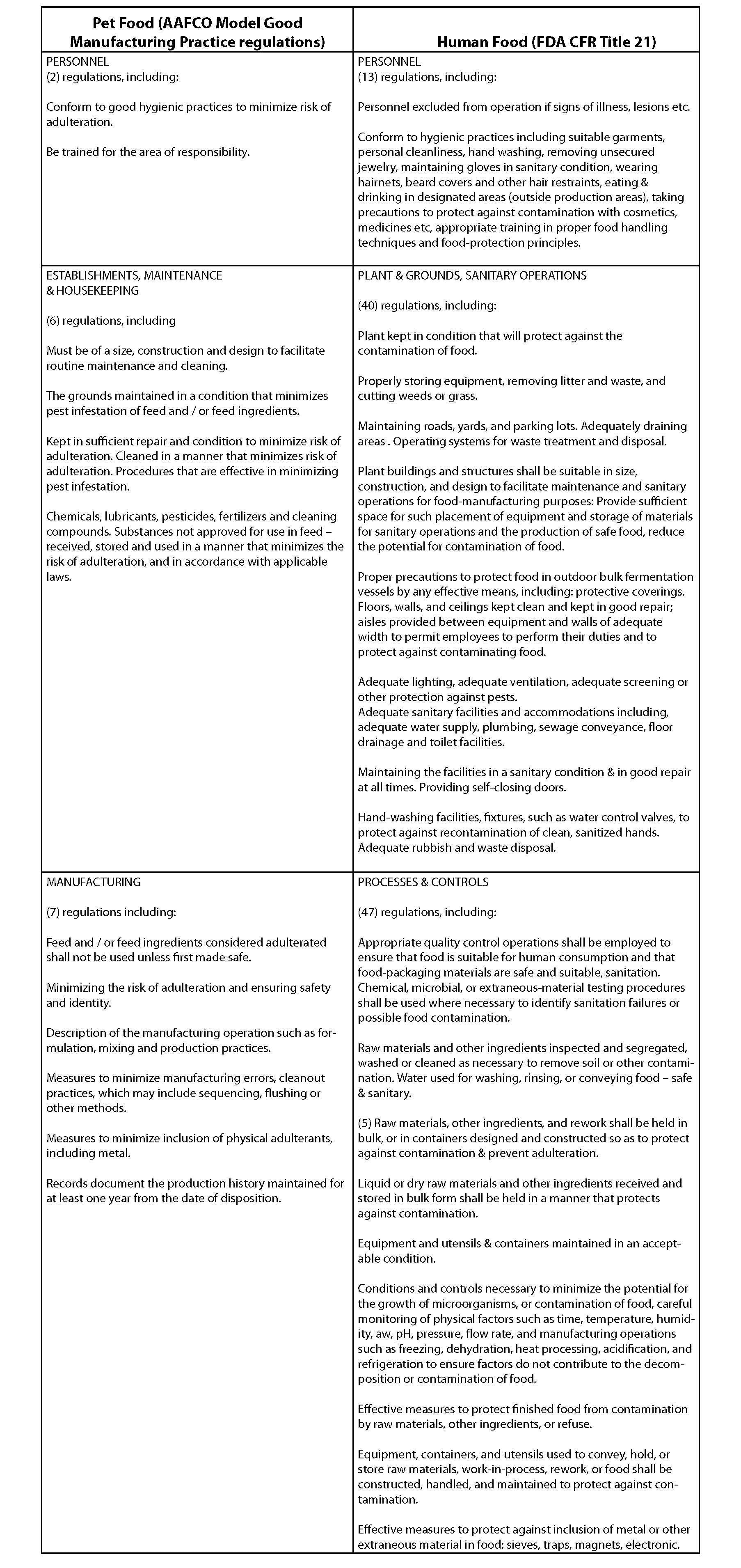What is Human Grade Pet Food, Really?

A number of pet food companies make claims that their products are ‘human quality’ or ‘table grade’...
...but these are not actually legally defined terms and only a product that is actually produced in a plant that produces human foods, may legally be labeled ‘human grade’. Pet owners should also beware of pet food manufacturers that that use ‘human grade’ (or related terms) liberally on their web sites and other marketing materials—but don’t actually state it on the bag. Short-staffed and under-funded labeling inspectors generally only have time to investigate claims made on packaging and don’t usually review the online and printed marketing pitch when they investigate (or license) a product.Definitions
Human-Grade or Food-Grade refers to the quality of a finished product. The term applies to a product that is legally suitable and approved for consumption by a person (“edible”). Feed-Grade applies to a product that is not suitable for consumption by people and is only legally allowed to be fed to animals (“inedible”) because of the ingredients it contains or the way it (or its ingredients) have been processed. Various ingredients used in many poor-quality pet foods are not fit for human consumption at all, and may include by-products, chemicals, fillers and parts from ’4D’ meats (animals which are dying, diseased, disabled or deceased). These ingredients do not have ‘edible’ because they are produced in a manner that makes them unfit for human consumption or are otherwise contaminated and unsafe for people to consume. A good example is rendered meat. Meat rendering plants are defined by the Environmental Protection Agency (EPA) as,“Meat rendering plants process animal by-product materials for the production of tallow, grease, and high-protein meat and bone meal….. Independent plants obtain animal by-product materials, including grease, blood, feathers, offal, and entire animal carcasses,from the following sources:butcher shops, supermarkets, restaurants, fast-food chains, poultry processors, slaughterhouses, farms, ranches, feedlots, and animal shelters.” The term “Made with Human-Grade Ingredients” does not mean that a finished product is actually, legally, human grade either. An ingredient (let’s say, a carrot) may start off being fit for human consumption, but once that carrot has been shipped to a pet food plant and processed in accordance with regulations for feed-grade products, the ‘human-grade’ term can no longer legally be used. By definition, that carrot is now feed-grade. Human food is produced in accordance with the FDA (Food and Drug Administration) Code of Federal regulations (CFR)Title 21. The CFR is a very in-depth document that defines how human food production should take place, and under what conditions. The FDA is currently working on legislation for the regulation of pet food, and its web site defines this as follows: “There is no requirement that pet food products have pre-market approval by the FDA. However, FDA ensures that the ingredients used in pet food are safe and have an appropriate function in the pet food. Many ingredients such as meat, poultry and grains are considered safe and do not require pre-market approval. Other substances such as sources of minerals, vitamins or other nutrients, flavorings and preservatives, or processing aids may be generally recognized as safe (GRAS) for their intended use (See Title 21 CFR 582 and 584) or must have approval as food additives…” The FDA’s Federal Food, Drug, and Cosmetic Act (FFDCA) requires that pet foods, like human foods, be safe to eat, produced under sanitary conditions, contain no harmful substances, and be truthfully labeled. AAFCO, the Association of American Feed Control Officials, is a corporation whose purpose is to provide a mechanism for establishing and maintaining equitable laws, regulations and definitions and enforcement policies for regulating the manufacture, labeling, distribution and sale of animal feeds. Many states follow the regulations established by AAFCO, though each state can have its own regulations and feed control laws.How does human food production actually differ from pet food production?
The following table provides abbreviated excerpts from the AAFCO regulations for feed production (AAFCO Official Publication 2010) and the FDA’s CFR Title 21 for human food production. The table outlines some of the contrasts between the regulations for (food grade) human food and (feed grade) pet food. AAFCO Feed Definitions:
Adulteration means the presence of any poisonous or deleterious substance at a level that may render the feed and / or feed ingredient injurious to human or animal health.
Establishment includes, but is not limited to, buildings structures, facilities, equipment and conveyances that receive, store, manufacture, process, package, label, transport or distribute feed and / or feed ingredients.
Pest means any objectionable animal including but not limited to bats, birds, rodents, insects and insect larvae.
In addition to the above model regulations for feed manufacturing, AAFCO places a major emphasis on feed definitions and terms, label format, brand and product names, expression of guarantees, ingredient definitions and terms, nutritional adequacy and other details which pertain to a pet food label.
Pet food labeling is regulated at two levels. The current FDA regulations require proper identification of the product, net quantity statement, name and place of business of the manufacturer or distributor, and a proper listing of all the ingredients in the product in order from most to least, based on weight.
When shopping the pet food aisle, look for a brand that is marked as being produced in a human food factory under FDA or USDA inspection. If in doubt, call your pet food manufacturer and ask them what sort of facility produces their products, and what inspections that facility undergoes.
© 2013 Lucy Postins & The Honest Kitchen This article may only be copied with prior written permission from the company. Reproductions must include credit to the author and a link to this website.
AAFCO Feed Definitions:
Adulteration means the presence of any poisonous or deleterious substance at a level that may render the feed and / or feed ingredient injurious to human or animal health.
Establishment includes, but is not limited to, buildings structures, facilities, equipment and conveyances that receive, store, manufacture, process, package, label, transport or distribute feed and / or feed ingredients.
Pest means any objectionable animal including but not limited to bats, birds, rodents, insects and insect larvae.
In addition to the above model regulations for feed manufacturing, AAFCO places a major emphasis on feed definitions and terms, label format, brand and product names, expression of guarantees, ingredient definitions and terms, nutritional adequacy and other details which pertain to a pet food label.
Pet food labeling is regulated at two levels. The current FDA regulations require proper identification of the product, net quantity statement, name and place of business of the manufacturer or distributor, and a proper listing of all the ingredients in the product in order from most to least, based on weight.
When shopping the pet food aisle, look for a brand that is marked as being produced in a human food factory under FDA or USDA inspection. If in doubt, call your pet food manufacturer and ask them what sort of facility produces their products, and what inspections that facility undergoes.
© 2013 Lucy Postins & The Honest Kitchen This article may only be copied with prior written permission from the company. Reproductions must include credit to the author and a link to this website.


